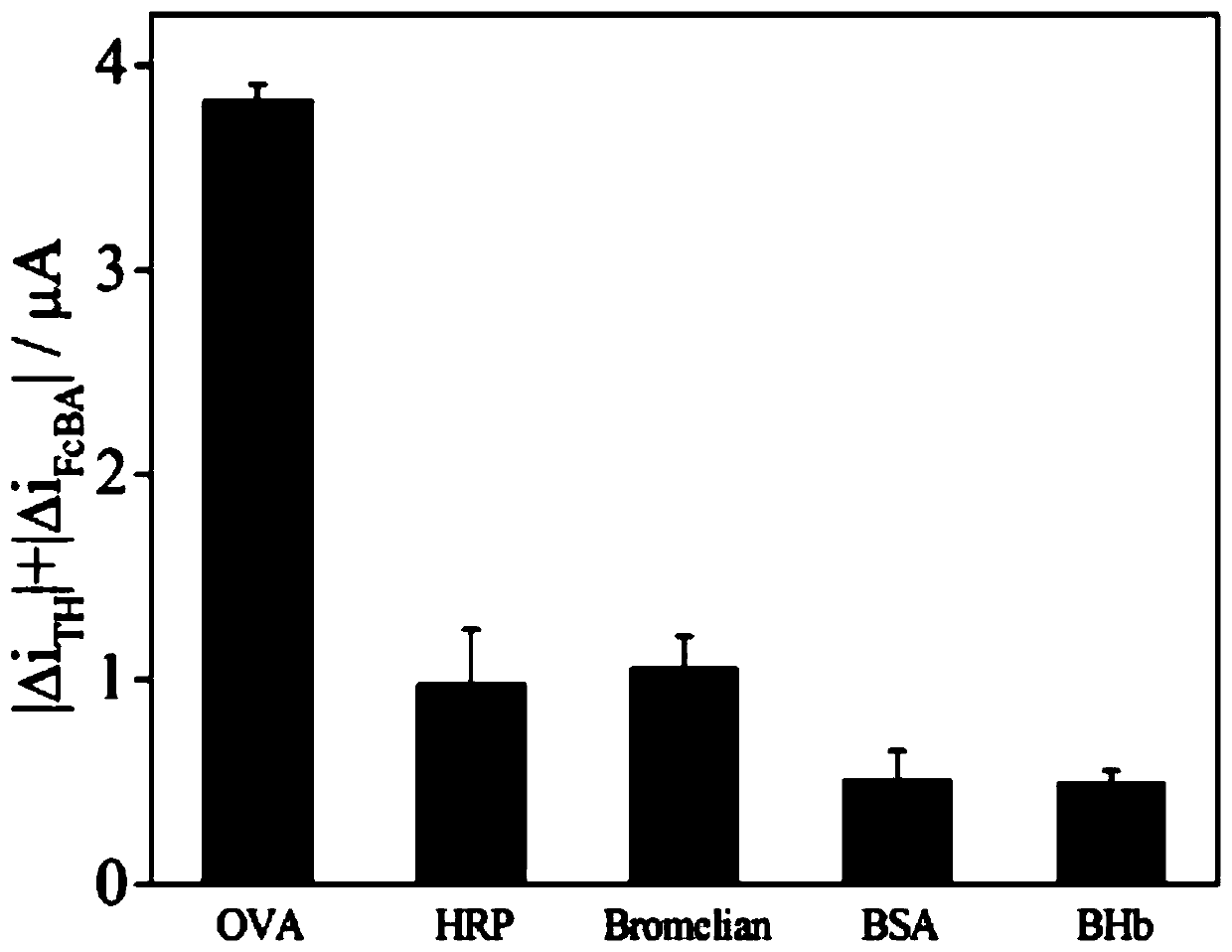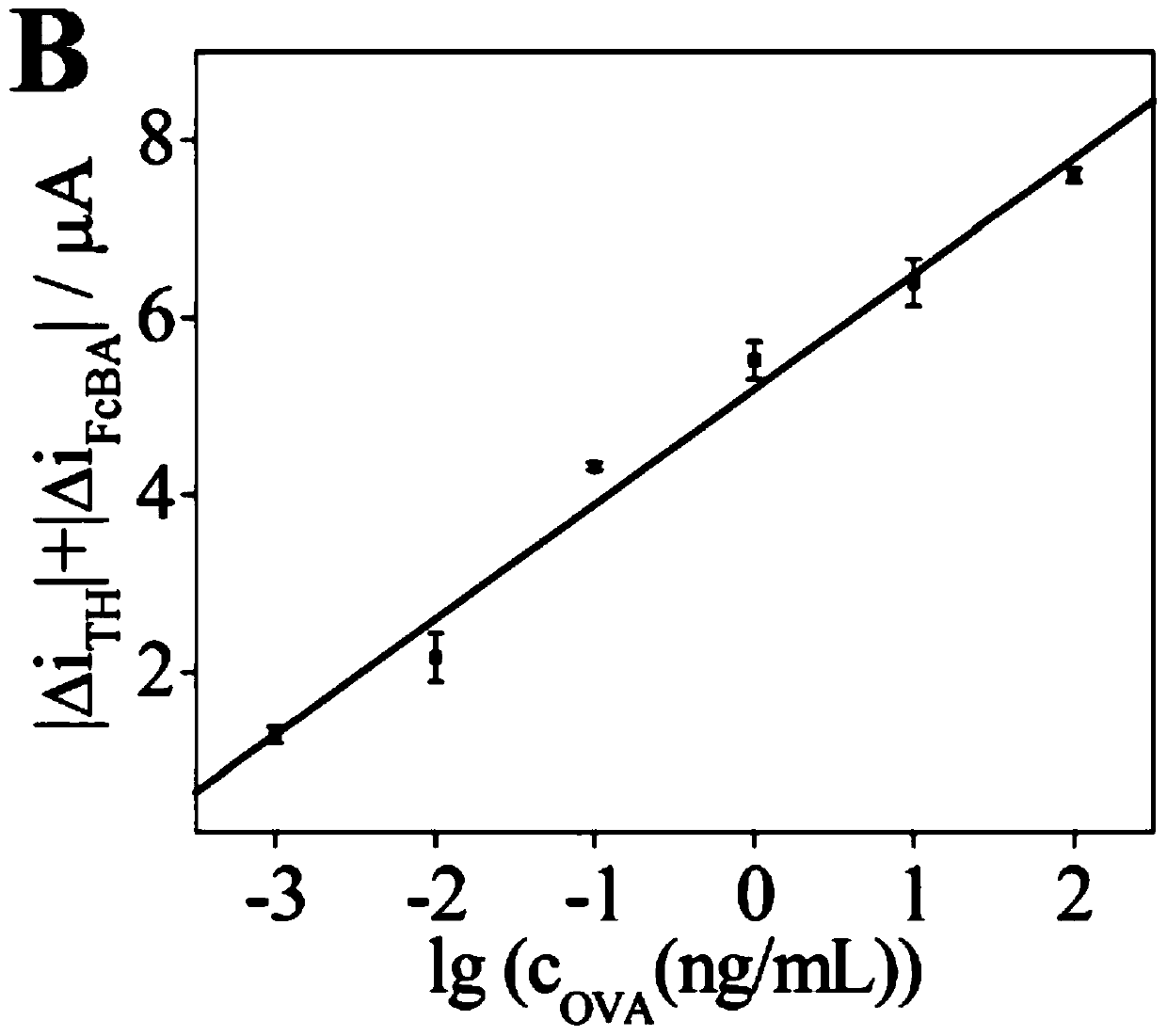Double signal-double recognition imprinted electrochemical sensor and preparation method thereof and detection method of ovalbumin
A technology of ovalbumin and detection methods, applied in the field of imprinted electrochemical sensors, can solve the problems of expensive, time-consuming, poor selectivity, etc.
- Summary
- Abstract
- Description
- Claims
- Application Information
AI Technical Summary
Problems solved by technology
Method used
Image
Examples
preparation example Construction
[0024] The invention provides a method for preparing a double-signal-double-recognition imprinted electrochemical sensor, the preparation method comprising:
[0025] 1) Perform electrochemical polymerization on the surface of the electrode carrier to form a poly(p-aminobenzenesulfonic acid) film pABSA to obtain pABSA / electrode carrier;
[0026] 2) Carry out electrochemical polymerization on the surface of pABSA / electrode carrier to form polythionine film pTH to obtain pTH / pABSA / electrode carrier;
[0027] 3) placing the pTH / pABSA / electrode carrier in a mixed solution for electrochemical polymerization, and then eluting the electrode to remove ovalbumin OVA to form an imprinted polymer MIP to obtain MIP / pTH / pABSA / electrode carrier;
[0028] Wherein, the mixed solution contains ovalbumin OVA and 3-thiophene boronic acid 3-TBA.
[0029] In step 1) of the above preparation method, the conditions of electrochemical polymerization can be selected in a wide range, but in order to ma...
Embodiment 1
[0049] 1) Preparation of pABSA / GCE
[0050] Immerse the glassy carbon electrode GCE containing 2×10 -4 mol / L ABSA in PBS solution with a pH of 7.0, scan 15 cycles by CV method, the polymerization potential is -1.5~+2.5V, and the scanning speed is 100mV / s, rinse the polymerized electrode with deionized water, and then pABSA / GCE was obtained.
[0051] 2) Preparation of pTH / pABSA / GCE
[0052] Immerse pABSA / GCE in PBS solution with pH 5.0 containing 5mmol / L TH, scan 30 times by CV method, the polymerization potential is -0.4~+0.4V, and the scanning speed is 100mV / s, and use the polymerized electrode Rinse with deionized water to obtain pTH / pABSA / GCE.
[0053] 3) Preparation of imprinted electrochemical sensors
[0054] Immerse pTH / pABSA / GCE in PBS solution at pH 8.0 containing 10mmol / L 3-TBA and 0.4mg / mL OVA, and conduct electropolymerization by CV method: the potential range is -0.2~+1.2V, and the sweep rate is 125mV / s, the number of aggregation circles is 20 circles. Then...
Embodiment 2
[0056] 1) Preparation of pABSA / GCE
[0057] Immerse the glassy carbon electrode GCE containing 1 × 10 -4 mol / L ABSA in PBS solution with a pH of 7.5, scan 18 circles by CV method, the polymerization potential is -1.5~+2.5V, and the scanning speed is 80mV / s, rinse the polymerized electrode with deionized water, then pABSA / GCE was obtained.
[0058] 2) Preparation of pTH / pABSA / GCE
[0059] Immerse pABSA / GCE in PBS solution with pH 5.5 containing 4mmol / L TH, scan 32 circles by CV method, the polymerization potential is -0.4~+0.4V, and the scanning speed is 80mV / s. Rinse with deionized water to obtain pTH / pABSA / GCE.
[0060] 3) Preparation of imprinted electrochemical sensors
[0061] Immerse pTH / pABSA / GCE in a PBS solution with a pH of 8.5 containing 8mmol / L 3-TBA and 0.3mg / mL OVA, and conduct electropolymerization by CV method: the potential range is -0.2~+1.2V, and the sweep rate is 120mV / s, the number of aggregation circles is 22. Then the obtained modified electrode wa...
PUM
 Login to View More
Login to View More Abstract
Description
Claims
Application Information
 Login to View More
Login to View More - R&D
- Intellectual Property
- Life Sciences
- Materials
- Tech Scout
- Unparalleled Data Quality
- Higher Quality Content
- 60% Fewer Hallucinations
Browse by: Latest US Patents, China's latest patents, Technical Efficacy Thesaurus, Application Domain, Technology Topic, Popular Technical Reports.
© 2025 PatSnap. All rights reserved.Legal|Privacy policy|Modern Slavery Act Transparency Statement|Sitemap|About US| Contact US: help@patsnap.com



